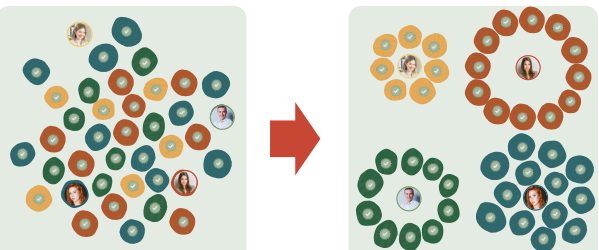Master Entities
A Master Entity is a data object in the data model that stores unified customer records. The output of deduplication, augmentation, and promotion of source customer records are stored in corresponding master entities.
Identity Resolution
The identity resolution process takes your source customer records and unifies, augments, and promotes it to a corresponding master entity.
-
The unification process is also referred as deduplication, where Unity scrutinizes your data to find all records belonging to distinct persons or objects, and maps them to one master identifier
-
The augmentation process adds grouping and computational attributes that add intelligence to your data set
-
Promotion determines the highest-fidelity data records for each distinct person or object
Example: If customer "John Smith" has profile data such as name, address, and email recorded across several attributes in the data model, Oracle Unity will compare that data during deduplication and ensure that John Smith is not counted as multiple customers. Once that is complete, all of Mr. Smith's profile records will be linked and promoted to the master entity data object (MasterCustomer) during promotion.
These processes happen automatically when you run the Identity resolution pipeline job (ID Resolution job). Through deduplication, merge, and promotion, the Identity Resolution Pipeline job matches customer data across multiple sources and ensures customer records are not duplicated.

Next the Customer 360 job uses all the attribute data to create customer profiles to create a better picture of customers.

The out-of-the-box deduplication, augmentation, and promotion capabilities likely meet most of your business needs already. We recommend you start by running the Identity resolution pipeline job without making any configuration changes first. Then review your mastered entities and make any necessary changes based on what you see (or hoped to see). It's safe to experiment with the data objects of mastered and relationship data to build them up gradually, and iterate on them until they meet your requirements.
Default Master Entities
The out-of-the-box Master Entities differ based on your data model. The following table lists the Master Entities for each Unity Data Model.
| Unity Data Model | Default Master Entities |
|---|---|
| B2C |
|
| B2B |
|
| Automotive |
|
You can make changes to a master entity data object by adding attributes to it.
Creating new Master Entities
Refer to the Oracle Unity Help Center for instructions on how to create new Master Entities.